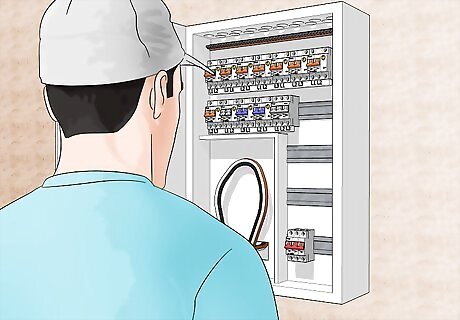
views
Using Power Cords and Outlets Safely

Unplug electronic appliances when you aren’t using them. Some electronics use power when they’re plugged in, even if they aren’t turned on and in use. Unplug the power cords for any electronics you aren’t currently using to avoid overloading your home’s electrical circuits. You can tell that some items are using power when they’re not technically on because they have a standby light. For instance, things like DVD players might have a little red or orange light on when they are turned off.

Pull power cords out from outlets by holding the plug. Don’t pull power cables out by yanking on the cord itself. Always go right to the outlet and pull the plug itself straight out of the outlet. If you pull power cords out by yanking on the cable, instead of the plug, they can wear out over time, which can lead to short circuits.

Keep electrical cords away from sources of heat and water. Avoid placing power cords and electrical cables next to a heater, fireplace, or other heat source. Keep them off of surfaces where water can accumulate, such as bathroom and kitchen floors and counters. Heat and moisture can both damage electrical wiring and cause short circuits.

Use power bars and multi-plug outlet adapters only when it’s necessary. Never plug more than 1 power bar or multi-plug outlet adapter per electrical outlet. Only use them when you absolutely need to in order to plug in all your electronics, like behind your TV and entertainment center. If you use too many power bars or outlet adapters, it’s really easy to overload your outlets and cause a short circuit.

Repair or replace any appliances that have damaged wiring or power cables. Check your electrical appliances for signs of damaged wiring like tears and fraying. Avoid using any electrical appliances that show signs of wear in their electrical wiring and get them repaired by an appliance technician or get rid of them and buy new appliances. For example, if you see exposed colored wires between the plug and the protective outer cover of a power cord, replace the appliance or get it rewired.

Replace outlets with burn marks, sparks, burning smells, and buzzing sounds. These are all signs that your outlets are worn out or faulty and using them may cause a short circuit. Monitor all your outlets and replace them if you see burn marks around them, sparks coming out of them, or if they make a buzzing sound or emit a burnt smell.#*If you aren’t comfortable replacing an outlet yourself, call a licensed electrician to come replace it for you. They will also be able to inspect the wiring and make sure that the outlet is the only issue. This is more common for older outlets that are at least 15-25 years old. It is not as likely in a newer home.

Avoid running power cables underneath carpets and rugs. It’s easy to wear out these cords by walking over them repeatedly and you won’t notice it since they’re out of sight. Run power cords along walls instead to avoid wearing them out.Tip: If you’re having trouble getting power cords from appliances and devices to where they need to go, you can always add a new electrical outlet to your wall. It might be tempting to hide a power cord underneath a decorative rug, but there are better and safer ways to hide your cables. For example, you can get special moulding that sticks to your walls along the baseboards and snaps on top of cables to camouflage them and keep them out of the way.
Taking Other Preventive Measures

Replace 2-prong outlets with 3-prong outlets. Installing grounded outlets, which are the type that have 3 prongs, is an easy way to avoid short circuits because they help prevent high voltage jolts. This is especially true if you connect electrical appliances that have an internal short circuit to them. Always turn off the power at your breaker before you replace an electrical outlet. Call a licensed electrician to come replace your outlets if you aren’t comfortable doing it yourself.

Get a yearly electrical inspection performed by an electrician. Call a licensed electrician and schedule an inspection of your home’s electrical systems at least once a year. They will be able to identify any issues like faulty or worn out wiring and outlets and repair them before a short circuit happens. There are different things that can cause your home’s electrical systems to wear out. Sometimes, it’s just age or exposure to things like moisture. In other cases, pests might gnaw through electrical wiring. A professional electrician will be able to find issues you might not be aware of.

Get major appliances serviced once a year. Have an appliance technician or a qualified electrician inspect and service your major electrical appliances every year, especially ones that run at high speeds and have motors, such as washing machines. This will help prevent their wiring from wearing out and causing a short circuit. If you notice anything wrong with an appliance, such as strange sounds or smells, get it checked out and serviced right away.

Use only the most necessary electricity during a lighting storm. A lighting strike can cause a short circuit and power surge if it strikes an electrical circuit that is on. Limit your use of electrical items in your home to just the essential lights and appliances whenever there is a storm to reduce the risk of a short circuit and electrical fire. If there is no lighting, you don’t need to worry about your use of electricity during a storm.

Make sure your home has a fuse box or circuit breaker box installed. Pretty much all homes already have circuit breakers and fuses installed, which both exist to help prevent short circuits from happening. Get a circuit breaker box installed by a licensed electrician if your home does not have one for some reason. Fuse boxes work by melting a replaceable fuse when there is too much electricity running through it, which interrupts the flow of electricity through that fuse to prevent a short circuit. These are more common in old homes. A circuit breaker box flips a switch that disconnects wires when there is too much electricity flowing through a circuit. You then can just flip the switch back to the on position to reconnect the wires. These are installed in basically all new homes.




















Comments
0 comment